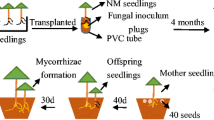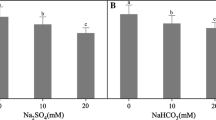Abstract
To evaluate the effect of ectomycorrhizal colonization on growth and physiological activity of Larix kaempferi seedlings grown under soil acidification, we grew L. kaempferi seedlings with three types of ectomycorrhizae for 180 days in acidified brown forest soil derived from granite. The soil had been treated with an acid solution (0 (control), 10, 30, 60, and 90 mmol H+ kg−1). The water-soluble concentrations of Ca, Mg, K, Al, and Mn increased with increasing amounts of H+ added to the soil. Ectomycorrhizal development significantly increased in soil treated with 10 and 30 mmol H+ kg−1 but was significantly reduced in soil treated with 60 and 90 mmol H+ kg−1. The concentrations of Al and Mn in needles or roots increased with increasing H+ added to the soil. The total N in seedlings significantly increased with increasing H+ in soil and colonization with ectomycorrhiza. The maximum net photosynthetic rate at light and CO2 saturation (P max) was greater in soil treated with 10 mmol H+ kg−1 than in controls, and was less is soils treated with greater than with 30 mmol H+ kg−1, especially with 60 and 90 mmol H+ kg−1. However, colonization with ectomycorrhiza significantly reduced the concentration of Al and Mn in needles or roots and increased the values of P max and total dry mass (TDM). The relative TDM of L. kaempferi seedlings was approximately 40% at a (BC, base cation)/Al ratio of 1.0. However, ectomycorrhizal seedlings had a 100–120% greater TDM at a BC/Al ratio of 1.0 than non-ectomycorrhizal seedlings, even though the acid treatment reduced their overall growth.





Similar content being viewed by others
References
Ahonen-Jonnarth U, Göransson A, Finlay RD (2003) Growth and nutrient uptake of ectomycorrhizal Pinus sylvestris seedlings in a natural substrate treated with elevated Al concentrations. Tree Physiol 23:157–167
Brunner I, Scheidegger C (1994) Effects of high nitrogen concentrations on ectomycorrhizal structure and growth of seedlings of Picea abies (L.) Karst. New Phytol 129:83–95
Brunner I, Frey B (2000) Detection and localization of aluminum and heavy metals in ectomycorrhizal Norway spruce seedlings. Environ Pollut 108:121–128
Brunner I, Brodbeck S (2001) Response of mycorrhizal Norway spruce seedlings to various nitrogen loads and sources. Environ Pollut 114:223–233
Choi DS, Kayama M, Jin HO, Lee CH, Koike T (2003) Growth and physiological responses of two pine species grown under polluted Ansan industrial region in Korea (in Japanese). Trans Hokkaido Branch Jpn For Soc 51:58–60
Choi DS, Jin HO, Lee CH, Kim YC, Kayama M (2005a) Effect of soil acidification on the growth of Korean pine (Pinus karaiensis) seedlings in a granite-derived forest soil. Environ Sci 12:33–47
Choi DS, Quoreshi AM, Maruyama Y, Jin HO, Koike T (2005b) Effect of ectomycorrhizal colonization on growth and photosynthetic characteristics of Pinus densiflora seedlings grown under elevated CO2 concentrations. Photosynthetica 43:223–229
Choi DS, Kayama M, Jin HO, Lee CH, Izuta T, Koike T (2006) Growth and photosynthetic responses of two pine species (Pinus koraiensis and P. rigida) planted in a polluted industrial region in Korea. Environ Pollut 139:421–432
Cronan CS, Reiners WA (1983) Canopy processing of acidic precipitation by coniferous and hardwood forests in New England. Oecologia 59:216–223
Cumming JR, Weinstein LH (1990) Aluminium–mycorrhizal interactions in the physiology of pitch pine seedlings. Plant Soil 125:7–18
Forest Research Institute (2000) Annual research report, Seoul, Korea (in Korean)
Göransson A, Eldhuset TD (1991) Effects of aluminium on growth and nutrient uptake of small Picea abies and Pinus sylvestris plants. Trees 5:136–142
Houle D, Ouimet R, Paquin R, Laflamme JG (1999) Interactions of atmospheric deposition with a mixed hardwood and a coniferous forest canopy at the lake clair watershed (Duchesnay, Quebec). Can J Forest Res 29:1944–1957
Hytteborn H, Maslov AA, Nazimova DI, Rysin LP (2005) Boreal forests of Eurasia. In: Andersson F (ed) Ecosystems of the world: coniferous forests, vol 6. Elsevier, Amsterdam, pp 23–99
Izuta T, Totsuka T (1996) Effects of soil acidification on growth of Cryptomeria japonica seedlings. In: Proceedings of the international symposium on acidic deposition and its impacts, pp 157–164
Izuta T, Yamaoka T, Nakaji T, Yonekura T, Yokoyama M, Funada R, Koike T, Totsuka T (2004) Growth, net photosynthesis and leaf nutrient status of Fagus crenata seedlings grown in brown forest soil acidified with H2SO4 or HNO3 solution. Trees 18:677–685
Joo YT, Jin HO, Son YH, Oh JM, Jung DY (1999) The effects of the interaction between precipitation and tree species on the chemical properties of throughfall and stemflow (in Korean with English summary). J Korean For Soc 88:149–156
Kaiser WM, Weiner H, Huber C (1999) Nitrate reductase in higher plants: a case study for transduction of environmental stimuli into control of catalytic activity. Physiol Plant 105:385–390
Koike T, Yazaki K, Funada R, Maruyama Y, Mori S, Sasa K (2000) Forest health and vitality in northern Japan. Research note of faculty of forestry. Forestry, The University of Joensuu 92:49–60
Krupa SV (2003) Effects of atmospheric ammonia (NH3) on terrestrial vegetation: a review. Environ Pollut 124:179–221
Lambers H, Chapin FS III, Pons TL (1998) Plant physiological ecology. Springer, New York
Larcher W (2004) Physiological plant ecology, 4th edn. Springer, Heidelberg
Marschner H (1995) Mineral nutrition of higher plants, 2nd edn. Academic Press, New York
Nakamura Y, Krestov PV (2005) Coniferous forests of the temperate zone of Asia. In: Andersson F (ed) Ecosystems of the world: coniferous forests, vol 6. Elsevier, Amsterdam, pp 163–220
Osama K, Nouchi I, De Kok LJ (2005) Plant responses to air pollution and global change. Springer, Tokyo
Qu L, Quoreshi AM, Iwase K, Tamai Y, Funada R, Koike T (2003) In vitro ectomycorrhiza formation on two larch species of seedlings with six different fungal species. Eurasian J For Res 6:65–73
Qu L, Ji D, Shi F, Sasa K, Koike T (2005) Growth and photosynthetic performance of seedlings of two larch species grown in shaded conditions. Eurasian J For Res 8:43–51
Rengel Z (1992) Role of calcium in aluminum toxicity. New Phytol 121:499–513
Schulze ED, Beck E, Müller-Hohenstein (2005) Plant ecology. Springer, Berlin
Sverdrup H, Warfvinge P, Nihlgärd B (1994) Assessment of soil acidification effects on forest growth in Sweden. Water Air Soil Pollut 78:1–36
Taiz L, Zeiger E (2006) Plant physiology, 4th edn. Sinauer Associates, Inc., Sunderland
Ulrich B, Mayer R, Khanna PK (1980) Chemical changes due to acid precipitation in a loss-derived soil in Central Europe. Soil Sci 130:193–199
Ulrich B (1989) Effects of acidic precipitation on forest ecosystems in Europe. In: Adriano DC, Johnson HJ (eds) Acidic precipitation: biological and ecological effects, vol 2. Springer, New York, pp 189–272
van der Heijden MGA, Sanders IR (2002) Mycorrhizal ecology. Springer, Berlin
Acknowledgements
Partial financial support by Japan Society for the Promotion of Science (JSPS) is gratefully acknowledged. Authors thank Dr. M. Kayama of FFPRI, Kyushu Research Center for selection of the site for getting forest soil.
Author information
Authors and Affiliations
Corresponding author
Additional information
Communicated by W. Oßwald.
Rights and permissions
About this article
Cite this article
Choi, D.S., Jin, H.O., Chung, D.J. et al. Growth and physiological activity in Larix kaempferi seedlings inoculated with ectomycorrhizae as affected by soil acidification. Trees 22, 729–735 (2008). https://doi.org/10.1007/s00468-008-0233-8
Received:
Revised:
Accepted:
Published:
Issue Date:
DOI: https://doi.org/10.1007/s00468-008-0233-8




